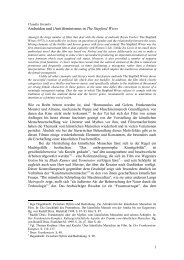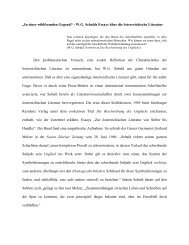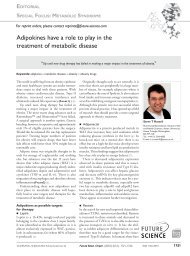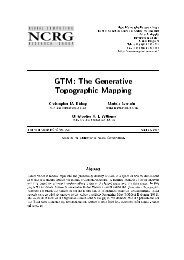PDF (State-of-the-art in integrated vehicle - Aston University ...
PDF (State-of-the-art in integrated vehicle - Aston University ...
PDF (State-of-the-art in integrated vehicle - Aston University ...
You also want an ePaper? Increase the reach of your titles
YUMPU automatically turns print PDFs into web optimized ePapers that Google loves.
equipment manufacturers <strong>of</strong> <strong>vehicle</strong> components because field performance data can be<br />
used to improve future designs [8].<br />
F<strong>in</strong>d<strong>in</strong>g 5: IVHM technology has many potential drivers. To mission operations, it means<br />
maximis<strong>in</strong>g <strong>the</strong> exploitation <strong>of</strong> <strong>vehicle</strong> capabilities, to ma<strong>in</strong>tenance operations<br />
is it a release from time-based policies, and for support operations it allows a<br />
more aggressive on-demand management.<br />
Barriers to <strong>the</strong> adoption <strong>of</strong> IVHM: IVHM br<strong>in</strong>gs with it significant economic and<br />
cultural challenges. Most authors [33], [1], [26] see <strong>the</strong> ma<strong>in</strong> barrier to <strong>the</strong> adoption <strong>of</strong><br />
IVHM as <strong>the</strong> cost <strong>of</strong> hardware and s<strong>of</strong>tware. Reichard et al. [7] <strong>in</strong>dicate that this cost<br />
<strong>in</strong>cludes not only <strong>the</strong> development <strong>of</strong> <strong>the</strong> sensors and data process<strong>in</strong>g, but also <strong>the</strong> penalty<br />
costs associated with additional weight, power, comput<strong>in</strong>g and communication resources.<br />
Also, many <strong>of</strong> <strong>the</strong> IVHM technologies have been developed relatively recently and <strong>in</strong><br />
only a few cases on actual systems, mak<strong>in</strong>g it difficult to carry out accurate cost-benefit<br />
analyses [10]. One <strong>of</strong> <strong>the</strong> earliest criticisms <strong>of</strong> IVHM was <strong>the</strong> possibility false alarms and<br />
o<strong>the</strong>r IVHM <strong>in</strong>duced problems, such as sensor failures. These criticisms were supported<br />
by reported cases <strong>of</strong> <strong>in</strong>adequate or faulty sensors which caused premature term<strong>in</strong>ation <strong>of</strong><br />
components or failure to detect faults <strong>in</strong> critical structures [12]. The costs and benefits <strong>of</strong><br />
IVHM are directly related to how early <strong>in</strong> <strong>the</strong> design it is considered [5], [11], [27] and<br />
this requires a significant change <strong>in</strong> <strong>the</strong> way <strong>vehicle</strong> systems are designed [36].<br />
F<strong>in</strong>d<strong>in</strong>g 6: The pr<strong>in</strong>cipal barrier to <strong>the</strong> adoption <strong>of</strong> IVHM is <strong>in</strong> <strong>the</strong> need to accurately<br />
assess <strong>the</strong> trade-<strong>of</strong>fs between associated costs, risks and revenues.<br />
Approaches to <strong>the</strong> design <strong>of</strong> IVHM systems: IVHM systems should be designed for a<br />
specific application and with consideration <strong>of</strong> <strong>the</strong> user’s requirements. IVHM systems<br />
can vary <strong>in</strong> scope depend<strong>in</strong>g on <strong>the</strong> different subsystems and components <strong>of</strong> <strong>the</strong> <strong>vehicle</strong><br />
[5]. IVHM technologies br<strong>in</strong>g <strong>the</strong> greatest benefit when <strong>the</strong>y are applied to <strong>the</strong> areas that<br />
have <strong>the</strong> most critical impact on <strong>vehicle</strong> performance and support costs [27], [33]. Even<br />
with<strong>in</strong> <strong>the</strong> same <strong>in</strong>dustrial sector, effective IVHM design depends upon <strong>the</strong> specific<br />
bus<strong>in</strong>ess case, market segment and <strong>vehicle</strong> owner [8], [15]. The relationships between <strong>the</strong><br />
designer and <strong>the</strong> users play a significant role <strong>in</strong> deliver<strong>in</strong>g an effective IVHM system.<br />
Bird et al. [8] and Scandura [15] both argue that successful implementation <strong>of</strong> IVHM<br />
requires knowledge <strong>of</strong> <strong>the</strong> factors that create value for several stakeholders such as<br />
ma<strong>in</strong>ta<strong>in</strong>ers, operators, OEMs and service providers <strong>in</strong> order to deliver <strong>the</strong> functionality<br />
that best reflects stakeholder priorities.<br />
F<strong>in</strong>d<strong>in</strong>g 7: An IVHM system needs to be designed on <strong>the</strong> specific case from <strong>the</strong> client<br />
perspective; it needs to select <strong>the</strong> top degraders <strong>of</strong> <strong>vehicle</strong> performance and<br />
provide <strong>the</strong> functions that deliver <strong>the</strong> greatest value to <strong>the</strong> users.<br />
IVHM design tools: Keller et al. [27] describe a suite <strong>of</strong> processes and s<strong>of</strong>tware tools for<br />
IVHM development. An IVHM system may best be created as a series <strong>of</strong> layers<br />
perform<strong>in</strong>g different tasks with<strong>in</strong> <strong>the</strong> overall IVHM function [8], [15], [21]. Aaseng [6]<br />
suggests a distribution <strong>of</strong> IVHM system components between <strong>the</strong> <strong>vehicle</strong> and <strong>the</strong> logistics<br />
<strong>in</strong>frastructure while Kacprzynski et al. [37] present a model for assess<strong>in</strong>g IVHM sensor<br />
8















